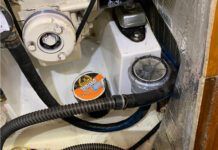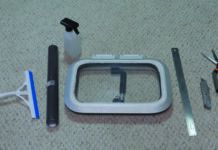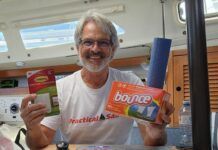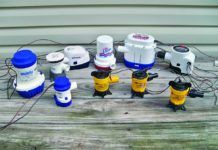Theres an old adage that when it comes to boats with teak decks, there are only two types of owners: those who have leaks and those who have them but don’t know it. Newer methods of bonding teak deck overlays in modern construction using fitting epoxies or other such products substantially reduces the need for screws (and the potential leaks associated with them); however, for boat owners with traditional decks or decks with mechanically fastened teak overlays, the quest remains the same: Find a seam caulk thats durable, easy to apply, bonds tenaciously to teak, remains flexible, and is resistant to both UV light and chemicals such as cleaners, oils, fuel, etc.
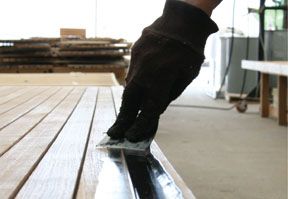
288
This review, the first of several looks into teak caulks, compares products ease of application. Future articles will address adhesion, strength, elasticity, and chemical resistance.
Few other boat-related tasks prompt such universal hatred among sailors as caulking a teak deck. Anxiety, loathing, despair, and endless hours of back-breaking, knee-wrecking agony are just some of the prospects associated with the job-and those are the highlights. Reefing out the old caulking, inspecting and prepping the seams (ensuring each is of sufficient depth and width, and is dry and oil free), installing (or blowing off) bond breaker tape, the troll-like shuffle up and down the decks dispensing a noxious black goo so insidious in nature as to actually leap onto any unsoiled surface within a 10-foot radius of the project-its no wonder those whove experienced it know any product that increases the time between caulking jobs is worth its weight in gold.
What we tested
The test group was a mix of polysulfide-, polyether-, Silyl Modified Polymer- (SMP), and silicone-based products; it also included both single and two-part products. Test samples came in standard caulking gun cartridges, sausages with special guns, or in the case of the two-part caulk, empty cartridges for use during application. The caulks themselves are available in a wide variety of containers and quantities.
BoatLIFE provided three caulks for our comparison: Life-Caulk, Teak Deck Sealant, and Life-Calk Type P. Also included in the test were Simson Marine Special Range (MSR) Deck Caulk Plus, Maritime Teak Deck Caulking, Teakdecking Systems SIS 440 Teak Deck Caulking, and West Marines Multi Caulk Sealant.
BoatLIFE Life-Caulk
Life-Caulk is a one-part, polysulfide-based rubber compound advertised for use above and below the waterline on fiberglass, wood, metal, and glass. Its not recommended for use on plastics. It can be painted, but youll likely have to prime it first. Seam preparation includes cleaning with Life-Caulk Solvent & Cleaner, and on oily woods (such as teak), priming with Life-Caulk primer.
Bottom Line: Life-Caulk payed easily into the seam, but the requirement to prime each seam (along with having to wait one hour to caulk) adds additional steps and time to each caulking job. At $19 a cartridge, its also one of the more expensive caulks tested.
BoatLIFE Teak Deck Sealant
Bottom Line: Application-wise, Teak Deck Sealant was similar to BoatLIFEs Life-Caulk, but without the added step of priming the seams-and at $16 a tube, its also a little less expensive.
BoatLIFE Life-Caulk Type P
Life-Caulk Type P is a pourable, two-part polysulfide deck and hull seam compound with a 24-hour cure time (tack free in one hour) also advertised as being resistant to teak cleaners, oils, fumes, gasoline, and diesel.
Seams are cleaned with Life-Caulk Solvent & Cleaner, but no primer is necessary with Type P (black). If using Type H or any other color, youll have to prime with BoatLIFE Life-Caulk Primer. (Type P already contains the primer; the others don’t.)
Bottom Line: The only two-part caulk tested. Being pourable, its out of necessity thinner and runnier than the other caulks tested, a particularly noticeable characteristic when applying with a cartridge and caulk gun.
Bostik / Simson MSR Deck Caulk Plus
Seam preparation includes cleaning with Simson Cleaner E and priming with Simson Primer P. According to product literature, seams can be caulked between one and six hours after priming, and decks can be sanded after approximately seven days, depending on temperature and relative humidity.
Simson is one of the adhesives and sealants divisions of Bostik, an independently operating company that is part of the “specialties chemical group” of France-based Total, the fourth largest gas and oil company in the world.
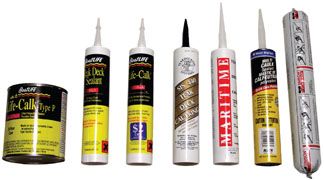
324
Bottom Line: Although “thickest” of all the caulks tested, MSR Deck Caulk Plus still applied fairly smoothly. As is the case with BoatLifes Life-Caulk, you have to prime each seam and wait one hour before caulking, again adding additional steps. The required cleaner and primer are pretty strong smelling, and at $12 and $40 a pint (respectively), they arent cheap.
Maritime Teak Deck Caulk
No primer is required, and denatured alcohol is the recommended cleaner when de-oiling seams. It is tack-free in 15-20 minutes, and you can sand in as little as 24 hours (depending on temperature and humidity). Full cure (maximum adhesion) takes approximately 14 days.
Maritime Teak Deck Caulk is available in black-white and custom colors are available, but a set minimum quantity is required. It has a shelf life of 18 months.
Bottom Line: Maritime Teak Deck Caulk and the other silicone-based test caulk, TDS SIS 440, were both exceptionally smooth and easily laid into the seams (possibly due to the slippery nature of silicone), with Maritime having a slight edge in the “smoothness” category. The minimum order for Maritime Teak Deck Caulk is by the case ($114 for 12 cartridges); however, this bulk purchase requirement makes it the least expensive caulk tested.
Teakdecking Systems
SIS 440 Teak Deck CaulkingFlorida-based Teakdecking Systems is an industry giant in the design and installation of custom teak decks, from private and production yachts to cruise ships. SIS 440 is a special seam compound designed specifically for TDS to complement the miles of seams they fill each year. According to TDS literature, SIS 440 is “a one-part, paste-like oxime cure system, which when exposed to moisture in the air reacts to form a tough, flexible solid rubber compound.”
It requires no primer, is tack-free in 20 to 40 minutes, and can be sanded in 48 hours. Its available in black or white, and has an 18-month shelf life.
Bottom Line: TDS was smooth and easy to apply. At $11 a tube, its the second least expensive caulk tested. As with other silicone products, SIS 440 is paintable, but may cause “fisheye” if nearby surfaces are not thoroughly cleaned of potential contaminates prior to painting or varnishing, particularly if decks are sanded after caulking. However, TDS maintains that because SIS440 is a fluid-free polymer, when cured, it wont cause the same problems associated with typical silicone products.
West Marine Multi Caulk Sealant
Product literature states Multi Caulk skins over in one hour and cures through one-eighth of an inch thickness in around two days (at 73 degrees and 70 percent relative humidity). Our test panel with its quarter-inch-by-quarter-inch seam was slightly tacky until Day 6.
Application instructions on the test cartridge read “no primer is required under normal conditions except new teak applications,” however it didnt state which primer to use in such cases. A quick call to West Marine clarified the issue: Primer in this case refers to a cleaning agent to remove surface oil and wax, so that the sealant can obtain a good bond to the wood. They recommend prepping new seams by wiping with a strong solvent such as methyl ethyl ketone (MEK), toluene, lacquer thinner, or acetone. We used MEK.
Bottom Line: The second thickest caulk tested, MultiCaulk nonetheless was easy to apply. However, it also took the longest to cure tack-free to the touch.
Conclusion
The other end of the mastic-covered stick is not only the requirement to prime, but the problems that can arise when directions arent followed. Primers typically can be applied only once, meaning if you miss the application window, youll have to sand the seams again and re-apply the primer. Its also interesting to note the varying philosophies manufacturers have with regard to seam cleaning, even with somewhat similar products. Take the two silicone-based products we tested: Maritime Wood Products recommends de-oiling seams with denatured alcohol as some acetones contain wax; Teakdecking Systems recommends acetone or mineral spirits. Wax and mineral oil are both detrimental to caulk adhesion. This seems an obvious contradiction. Perhaps theyre both right and just base their recommendations on the one they feel is more of a threat to their respective products.
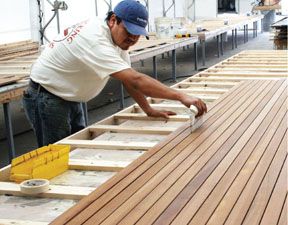
288
One-part caulks are less of a potential headache than two-part caulks. Even though you follow the directions for mixing to the letter, theres always that nagging worry youve somehow screwed up and it wont cure properly or-horror of horrors-you somehow manage to tip over the can (You were mixing it on the dock and not the deck, right?). One-part caulks come pre-mixed in nice, safe tubes or sausages, helping us protect ourselves from such self-inflicted woes.
Based on preliminary evaluations concerning ease of application and our preferences stated above, three products stand out: Teakdecking Systems SIS 440 Teak Deck Caulking, BoatLIFE Teak Deck Sealant, and Maritime Teak Deck Caulk. Of these three, TDS and Maritime are tied at this point, with Teak Deck Sealant a close second (primarily because it costs more than the other two and requires the added expense of a special seam cleaner).
We were also impressed by Life-Caulk and MSR Deck Caulk Plus during the application process, however the additional requirement (and expense) to prime each seam is a disadvantage, in our opinion. Wed gladly suffer these additional requirements if it meant a caulk job that was decidedly superior and longer lasting; however, if you can get equal results without having to prime, youve come out ahead.
We have the same thoughts on one-part vs. two-part caulks such as Life-Caulk Type P. If a one-part product delivers comparable performance without the need to mix, wed chose it. As for West Marines Multi Caulk Sealant, the only disadvantage we note at this point is the length of cure time as compared with the other caulks during our initial test.
We would hesitate to make any recommendations based solely on the above factors. The upcoming chemical tests should give us a clearer picture of whether our initial impressions hold water-or not, as the case may be.
Contacts
BoatLIFE, 843/566-1225, www.boatlife.com/
Bostik Inc., 800/523-2678, www.bostikfindley-us.com/
Maritime Wood Products, 772/287-0463, www.maritimewoodproducts.com/
Teak Decking Systems, 941/756-0406, www.teakdecking.com/
West Marine, 800/685-4838, www.westmarine.com/













